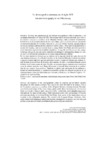Mostrar o rexistro simple do ítem
La lexicografía asturiana en el siglo XIX
| dc.contributor.author | Busto Cortina, Juan Carlos | |
| dc.date.accessioned | 2021-05-14T08:20:38Z | |
| dc.date.available | 2021-05-14T08:20:38Z | |
| dc.date.issued | 2021-01-30 | |
| dc.identifier.citation | Busto Cortina, J. C. (2021). La lexicografía asturiana en el siglo XIX. Revista de Lexicografía, 26, 7-29. https://doi.org/10.17979/rlex.2020.26.0.6823 | es_ES |
| dc.identifier.issn | 2603-6673 | |
| dc.identifier.issn | 1134-4539 | |
| dc.identifier.uri | http://hdl.handle.net/2183/27938 | |
| dc.description.abstract | [Resumen] Se traza una panorámica de los trabajos lexicográficos sobre el asturiano y sus variedades dialectales a lo largo del XIX. Dos ocupan toda la primera mitad del siglo. Uno el Vocabulario asturiano y castellano de la «Hispanic Society», dado a conocer recientemente. El análisis de su léxico (procedencia de las voces, hápax, ghost words) muestra su vinculación con los textos editados por Caveda y Nava en su Colección (1839). Además, algunas propuestas léxicas normalizadoras son las mismas en ambos corpus. Otros indicios apuntan hacia el entorno de Caveda, y más en concreto hacia su amigo Pedro José Pidal, probable autor de la copia manuscrita según revela el análisis caligráfico. El segundo es el Diccionario de Junquera Huergo, del que se analizan ciertos aspectos metodológicos (neologismos, manejo de fuentes, etc.) y se refieren las vicisitudes de sus copias manuscritas aún inéditas.De los once repertorios léxicos que se realizan en la segunda mitad de siglo, dos son de muy dudosa existencia: el de Benito Canella y el de Arias de Miranda, limitado este último a algunos apuntes dispersos que han permitido conocer la parte de terminología médica. El artículo pasa revista al resto de léxicos y diccionarios, de valor y extensión desigual, que se elaboran en el último cuarto de siglo. De ellos se destacan algunos aspectos poco conocidos como la relación epistolar entre Hugo Schuchardt y Laverde Ruiz coetánea de la publicación de sus Apuntes lexicográficos. También se ofrece una valoración de los métodos y alcance de estos repertorios, y, cuando ello es posible, se hace revisión de las críticas de los contemporáneos como las formuladas por Acevedo y Huelves y por Braulio Vigón al Vocabulario de Apolinar Rato. | es_ES |
| dc.description.abstract | [Abstract] An overview of the lexicographical works on Asturian and its dialect varieties throughout the XIX century is drawn. Two occupy the entire first half of the century. One is the Vocabulario asturiano y castellano of the «Hispanic Society», recently released. The analysis of its lexicon (origin of the voices, hapax, ghost words) shows its connection with the texts edited by Caveda y Nava in their Colección (1839). Furthermore, some standardizing lexical proposals are the same in both corpus. Other indications point to the surroundings of Caveda, and more specifically to his friend Pedro José Pidal, likely author of the handwritten copy as revealed by the calligraphic analysis. The second is the Junquera Huergo Dictionary, from which certain methodological aspects (neologisms, management of sources, etc.) are analyzed and the vicissitudes of his still unpublished manuscript copies are referred to.Of the eleven lexical repertoires carried out in the second half of the century, two are of very dubious existence (those by Benito Canella and by Arias de Miranda, the latter limited to a few scattered notes that have made it possible to know the medical terminology part). The article reviews the rest of the lexicons and dictionaries, of unequal value and length, which were produced in the last quarter of the century: it highlights some little-known aspects such as the epistolary relationship between Hugo Schuchardt and Laverde Ruiz, contemporary with the publication of his Apuntes lexicográficos. It also offers an assessment of the methods and scope of these repertoires, and, when possible, a review of contemporary criticisms such as those made by Acevedo y Huelves and by Braulio Vigón on the Apolinar Rato Vocabulario is provided. | es_ES |
| dc.language.iso | spa | es_ES |
| dc.publisher | Universidade da Coruña | es_ES |
| dc.relation.uri | https://doi.org/10.17979/rlex.2020.26.0.6823 | es_ES |
| dc.rights | Atribución-NoComercial-CompartirIgual 4.0 Internacional (CC BY-NC-SA 4.0) | es_ES |
| dc.rights.uri | https://creativecommons.org/licenses/by-nc-sa/4.0 | |
| dc.subject | Lexicografía | es_ES |
| dc.subject | Asturiano | es_ES |
| dc.subject | Dialectología | es_ES |
| dc.subject | Diccionarios | es_ES |
| dc.subject | Vocabularios | es_ES |
| dc.subject | Asturian lexicography | es_ES |
| dc.subject | Dialectology | es_ES |
| dc.subject | Asturian language | es_ES |
| dc.title | La lexicografía asturiana en el siglo XIX | es_ES |
| dc.title.alternative | Asturian Lexicography in the 19th Century | es_ES |
| dc.type | info:eu-repo/semantics/article | es_ES |
| dc.rights.access | info:eu-repo/semantics/openAccess | es_ES |
| dc.date.updated | 2021-05-13T10:02:52Z | |
| UDC.journalTitle | Revista de Lexicografía | es_ES |
| UDC.volume | 26 (2020) | es_ES |
| UDC.startPage | 7 | es_ES |
| UDC.endPage | 29 | es_ES |
| dc.identifier.doi | 10.17979/rlex.2020.26.0.6823 |






